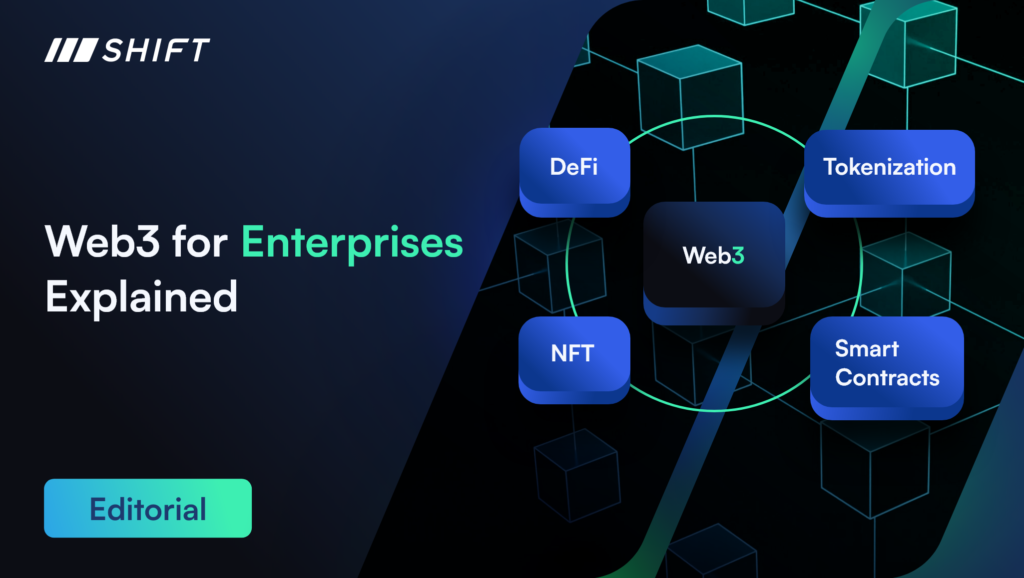Summarize with AI:
Web3 for Enterprises Explained
The buzz around Web3 has been inescapable, with proponents heralding it as the next evolution of the internet that will fundamentally transform how businesses operate. But is the hype around blockchain, decentralized finance (DeFi), and other Web3 innovations justified for enterprises? Or are these still nascent technologies not ready for real-world adoption?
In this article, we’ll cut through the noise to examine the practical realities of Web3 and how enterprises can leverage these emerging technologies to drive efficiency, security, and competitive advantage. We’ll take an objective editorial look at the opportunities and challenges Web3 presents for businesses.
Key Takeaways:
-
Web3 technologies like blockchain, cryptocurrencies, smart contracts, and decentralized finance (DeFi) open up new possibilities for businesses to transform how they operate, increase transparency, cut costs, and find fresh revenue opportunities.
-
Companies can utilize Web3 to enhance their B2B and B2C operations, automating processes, building trust, and finding creative new ways to engage customers and clients.
-
To effectively integrate Web3, businesses should take a phased approach – start with pilot projects, build up core skills and knowledge, and have a plan to manage risks around security, regulations, and market volatility.
What is Web3 and Why Should Enterprises Care?
The internet has evolved through different phases – from the static “read-only” Web1 to the interactive Web2 dominated by large platforms. Web3 represents the next phase, an internet built on decentralized blockchains that aims to recreate a more open and user-utility focused environment. Web3 refers to the idea of a new internet ecosystem built on these distributed ledger technologies behind cryptocurrencies like Ethereum. It represents a shift towards greater ownership and utility for users rather than relying on large technology platforms that act as gatekeepers.
Key pillars of Web3 include cryptocurrencies, decentralized finance (DeFi) platforms, non-fungible tokens (NFTs), and decentralized autonomous organizations (DAOs). For enterprises, ignoring this evolution to Web3 could mean missing out on transformative technologies that could increase transparency, reduce costs by cutting out middlemen, provide new revenue streams, and enhance data security. While still nascent, Web3 has significant momentum that makes it critical for businesses to explore.

Source: GlobeNewsWire
Web 3.0 Market Analysis Suggests Growth Outlook of 44.5% CAGR Topping USD 81.9 Billion market cap by 2032
Web3 Technologies Enterprises Should Understand
The Web3 ecosystem is powered by several core decentralized technologies, from the blockchain itself to the cryptocurrencies, smart contracts and platforms built on top of it. Rather than vague futuristic concepts, these are concrete innovations already being utilized and extended by developers, companies, and decentralized communities. For enterprises, understanding the mechanics and potential applications of these key Web3 building blocks is crucial to identifying real opportunities. Here’s a breakdown of the technologies at the heart of Web3’s vision:
Blockchain
The foundational distributed ledger technology allows transactions to be recorded transparently, securely and without a centralized authority. For enterprises, blockchain could streamline processes like supply chain tracking, increase data integrity and auditability, and reduce costs by disintermediating traditional intermediaries. Blockchain provides the base layer for many Web3 applications.
Cryptocurrencies
Native digital currencies like Ethereum and Solana facilitate secure global transactions without intermediaries like banks. Enterprises can use cryptocurrencies for cost-effective, swift international payments, tap into new capital markets via crypto exchanges, or launch branded tokens to boost user engagement and loyalty programs. Cryptocurrencies provide the liquidity layer for Web3.
Smart Contracts
Self-executing code deployed on the blockchain automates processes, facilitates transactions, and enforces agreements without third parties. This programmable money/assets opens up new models like automatic payouts, loyalty programs, and revenue sharing directly coded into contracts. Smart contracts enable enterprises to program business logic atop Web3.
Decentralized Finance (DeFi)
DeFi platforms offering services like lending, borrowing, trading and insurance built on blockchains remove the need for centralized financial intermediaries. DeFi could provide enterprises with new revenue streams from offering decentralized financial products or tapping into these alternative capital markets.
Non-Fungible Tokens (NFTs)
These unique, tradable blockchain-based assets enable authentication, verification and monetization of digital and physical goods. NFTs present enterprises with new branding opportunities, ways to incentivize customers and creators, and potential token-gated communities/memberships.
Enhancing Enterprise Profitability with Web3 Technologies
Web3 adoption presents compelling opportunities for enterprises across the board, whether their focus lies in B2B or B2C markets. This technology enables businesses to enhance their product offerings and operational models, catering to the specific needs and expectations of their diverse client bases.
Web3 B2B Apps
In the B2B sector, integrating blockchain technology into enterprise applications transforms how transactions and processes are managed. By adopting smart contracts, companies can automate agreements and ensure that terms are executed precisely as intended, reducing the need for intermediaries and lowering transaction costs. Web3 technology builds trust in business, particularly in supply chain management, through an immutable ledger documenting each product’s journey. This results in more transparent operations and significant reductions in time and costs required for process management and audits.
Web3 for B2C Apps
For B2C enterprises, the applications of Web3 technology are vast and ripe with opportunity. DeFi platforms could allow retailers to offer branded crypto-lending or investments directly to consumers as an additional product line. NFTs provide a novel approach to digital ownership, letting businesses create exclusive tokenized assets that build consumer loyalty and enable new membership/community models. DeFi gives customers more control over finances, with faster, secure alternatives to traditional banking that can attract underserved demographics. These Web3 components enhance the customer experience and access new markets seeking transparency and control over their digital interactions.
Identifying Opportunities and Taking Action
While the Web3 vision is ambitious, enterprises should start by looking for specific operational needs or growth opportunities where decentralized technologies can provide tangible value. This could include increasing supply chain transparency, automating workflows with smart contracts, creating new products/services monetized by crypto tokens, or tapping into DeFi markets.
Once potential use cases are identified, enterprises should initiate pilot projects and focus on developing core Web3 capabilities. This includes understanding the technical architecture, assembling the right talent and partners, and getting organizational buy-in. Change management is critical, as Web3 may require rethinking business models, IT systems, legal/compliance processes, and customer experiences from the ground up.
Start small by launching minimum viable Web3 products or initiatives. Run them through testing cycles, gather data, and iterate. Develop risk management strategies to address any security, regulatory or volatility concerns. Cultivate an agile, experimental mindset – Web3 remains uncharted territory with much to be learned through real-world implementation and consumer adoption. For enterprises, pragmatically integrating Web3 is about taking calculated steps toward a tech stack and operating model for the decentralized world.
Conclusion
As enterprises explore the emerging Web3 landscape, they embark on a journey from ideation to integration. This path offers a unique opportunity to redefine business models, enhance operational efficiencies, and open new channels for customer engagement.
The adoption of Web3 not only paves the way for innovative applications in both B2B and B2C arenas but also positions enterprises at the forefront of a digital revolution, ready to capitalize on the transformative potential of decentralized technologies.
By embracing Web3 technologies, businesses stand to gain an edge over their competition in an increasingly digital world, ensuring their relevance and success in the future of commerce. This nascent adoption of Web3 technologies marks the beginning of a new chapter for enterprises, one filled with promising opportunities for growth and lasting impact.
Partner with Shift Markets for Web3 Success
Shift Markets emerges as the ideal partner for companies ready to embrace Web3 and blockchain technologies. Our comprehensive suite of cryptocurrency software and technology empowers businesses to easily adopt Web3 innovations, ensuring they can confidently provide these advanced solutions to their clients. Reach out today to learn more.
Share this article:
Want to learn more?
Let us save you time by walking you through what Shift can do for your business!



